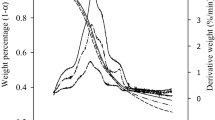Abstract
Purpose
Disposal of sewage sludge is becoming one of the most important issues in wastewater treatment: the 2005 EU sludge production was estimated at 9.5 million tons dry weight, up 54 % in 10 years. Sludge disposal costs may constitute 30–50 % of the total operation cost of WWTPs. Sewage sludge still contains resources that may be put to use, like nutrients and energy, that can be recovered through a variety of approaches.
Methods
Pyrolysis is a thermochemical decomposition process occurring by applying heat in absence of oxidizing agents; this way, chemical bonds are broken, with formation of simpler molecules, producing solid, gaseous and oil fractions that can be used as fuel or as prime material for chemical products. By applying microwave heating to achieve pyrolysis to the sludge under treatment, the more desirable production oil and gas fractions is increased and the residual solid fraction decreases.
Results
Microwave-assisted pyrolysis of urban waste sludge was applied for the production of oil and (Syn)gas, that were afterwards characterized and compared to mainstream alternative fuels (biodiesels). An energetic estimate of the process is performed and described. A key factor in deciding the positivity of the energetic balance (and therefore the economic validity of the process) is the correct “tuning” between microwave source and treated sample.
Conclusions
Based on our tests, the overall energy balance of the process is not always immediately favorable, however, by appropriately “tuning” the wave source and minimizing reflected radiation (lost energy) an energy-positive recovery of resources on one side, and considerable reduction of sludge volumes, on the other, may be achieved.





Similar content being viewed by others
References
David, B., et al.: Environmental, economic and social impacts of the use of sewage sludge on land Draft Summary Report 2 Baseline Scenario, Analysis of Risk and Opportunities, for the European Commission, DG Environment under Study Contract DG ENV.G.4/ETU/2008/0076r (2008)
Raboni, M., Viotti, P., Capodaglio, A.G.: A comprehensive analysis of the current and future role of biofuels for transport in the European Union. Revi. Amb. Agua, 9, Vol. 10 (2015)
Capodaglio, A.G. et al.: Process enhancement for maximization of methane production in codigestion biogas plants. Manag. Env. Qual. (in press, 2016)
Fuchs, W., Drosg, B.: Assessment of the state of the art of technologies for the processing of digestate residue from anaerobic digesters. Wat. Sci. Tech. 67(9), 1984–1993 (2013)
Siddiquee, M.N., Rohani, S.: Lipid extraction and biodiesel production from municipal sewage sludges: a review. Ren. Sust. Energy Rev. 15(2), 1067–1072 (2011)
Kwon, E.E., Kim, S., Jeon, Y.J., Yi, H.: Biodiesel Production from Sewage Sludge: new Paradigm for Mining Energy from Municipal Hazardous Material. Env. Sci. Technol. 46, 10222–10228 (2012)
Mushtaq, F., Mat, R., Ani, R.F.: A review on microwave assisted pyrolysis of coal and biomass for fuel production. Ren. Sust. Energy Rev. 39, 555–574 (2014)
Pastore, C., Lopez, A., Lotito, V., Mascolo, G.: Biodiesel from dewatered wastewater sludge: a two-step process for a more advantageous production. Chemosphere 92(6), 667–673 (2013)
Motasemi, F., Muhammad, R., Afzal, T.: A review on the microwave-assisted pyrolysis technique. Ren. Sust. Energy Rev 28, 317–330 (2013)
Lin, Q., et al.: Scale-up of microwave heating process for the production of bio-oil from sewage sludge. J. Anal. Appl. Phys. 94, 114–119 (2012)
Dominguez, A., Fernandez, Y., Fidalgo, B., Pis, J.J., Menendez, J.A.: Bio-syngas production with low concentrations of CO2 and CH4 from microwave-induced pyrolysis of wet and dried sewage sludge. Chemosphere 70, 397–400 (2008)
Yin, C.: Microwave-assisted pyrolysis of biomass for liquid biofuels production. Biores. Tech. 120, 273–284 (2012)
Menendez, J.A., et al.: Microwave-induced pyrolysis of sewage sludge. Wat. Res. 36(13), 3261–3264 (2002)
Grube, M., Lin, J.G., Lee, P.H., Kokorevicha, S.: Evaluation of sewage sludge-based compost by FT-IR spectroscopy. Geoderma 130, 324–333 (2006)
Hoekman, S.K., Broch, A., Robbins, C., Ceniceros, E., Natarajan, E.: Review of biodiesel composition, properties, and specifications. Ren. Sust. Energy Rev. 16, 143–169 (2012)
Author information
Authors and Affiliations
Corresponding author
Rights and permissions
About this article
Cite this article
Capodaglio, A.G., Callegari, A. & Dondi, D. Microwave-Induced Pyrolysis for Production of Sustainable Biodiesel from Waste Sludges. Waste Biomass Valor 7, 703–709 (2016). https://doi.org/10.1007/s12649-016-9496-2
Received:
Accepted:
Published:
Issue Date:
DOI: https://doi.org/10.1007/s12649-016-9496-2




